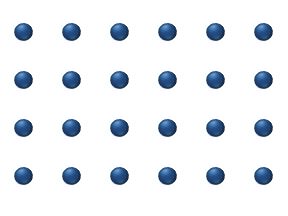Minimizing The optimal path in large N
The optimal paths for the fastest can be found using the Wencell-Freidlin functional in the Large-deviation theory. These paths correspond to the short-time asymptotics of the diffusion equation from a source to a target. In general, the exact solution is hard to find, especially for a space containing various distribution of obstacles.
The Wiener integral representation of the pdf for a pure Brownian motion is obtained for a zero drift and diffusion tensor  constant, so that it is given by the probability of a sampled path until it exits at the small window
constant, so that it is given by the probability of a sampled path until it exits at the small window  at the random time T
at the random time T


where
 in the product and T is the exit time in the narrow absorbing window
in the product and T is the exit time in the narrow absorbing window  Finally,
Finally,

where  is the ensemble of shortest paths selected among n Brownian trajectories, starting at point y and exiting between time t and t+dt from the domain
is the ensemble of shortest paths selected among n Brownian trajectories, starting at point y and exiting between time t and t+dt from the domain  . The probability
. The probability is used to show that the empirical stochastic trajectories of
is used to show that the empirical stochastic trajectories of  concentrate near the shortest paths starting from y and ending at the small absorbing window
concentrate near the shortest paths starting from y and ending at the small absorbing window  , under the condition that
, under the condition that  . The paths of
. The paths of  can be approximated using discrete broken lines among a finite number of points and we denote the associated ensemble by
can be approximated using discrete broken lines among a finite number of points and we denote the associated ensemble by  . Bayes' rule leads to
. Bayes' rule leads to where
where  is the probability that a path of
is the probability that a path of  exits in m-discrete time steps. A path made of broken lines (random walk with a time step
exits in m-discrete time steps. A path made of broken lines (random walk with a time step ) can be expressed using Wiener path-integral. The probability of a Brownian path x(s) can be expressed in the limit of a path-integral with the functional:
) can be expressed using Wiener path-integral. The probability of a Brownian path x(s) can be expressed in the limit of a path-integral with the functional:

The Survival probability conditioned on starting at y is given by the Wiener representation:

where  is the limit Wiener measure: the exterior integral is taken over all end points x and the path integral is over all paths starting from x(0). When we consider n-independent paths
is the limit Wiener measure: the exterior integral is taken over all end points x and the path integral is over all paths starting from x(0). When we consider n-independent paths  (made of points with a time step
(made of points with a time step  that exit in m-steps, the probability of such an event is
that exit in m-steps, the probability of such an event is

 .Indeed, when there are n paths of m steps, and the fastest one escapes in m-steps, they should all exit in m steps. Using the limit of path integral, we get heuristically the representation
.Indeed, when there are n paths of m steps, and the fastest one escapes in m-steps, they should all exit in m steps. Using the limit of path integral, we get heuristically the representation


where the integral is taken over all paths starting at y(0) and exiting at time  . This formula suggests that when n is large, only the paths that minimize the integrant will contribute. For large n, this formula suggests that paths that will contribute the most are the ones that will minimize the exponent, which allows selecting the paths for which the energy functional is minimal, that is
. This formula suggests that when n is large, only the paths that minimize the integrant will contribute. For large n, this formula suggests that paths that will contribute the most are the ones that will minimize the exponent, which allows selecting the paths for which the energy functional is minimal, that is

where the integration is taken over the ensemble of regular paths inside
inside  starting at y and exiting in
starting at y and exiting in  , defined as
, defined as

This formal argument shows that the random paths associated to the fastest exit time are concentrated near the shortest paths. Indeed, the Euler-Lagrange equations for the extremal problem are the classical geodesics between y and a point in the narrow window  .
.





















































































